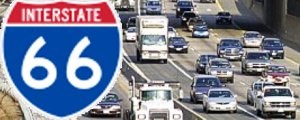 Image captured from the 66alliance website.
Image captured from the 66alliance website.If you commute on I-66, Greg Scott believes you should pay attention to VDOT’s plans for widening the roadway.
Warrenton resident Greg Scott launched a campaign requesting the Virginia Department of Transportation (VDOT) reconsider its plans for adding HOT (High Occupancy Toll) lanes on I-66 between Washington, D.C and Haymarket, Virginia.
“It started with six of us, sitting around, having coffee one time,” Scott said, of the group that has now grown to nearly 400 members.
Three weeks after the launch of his website, 66alliance.org, Scott’s campaign has garnered both media attention and popular support via a local NBC television news segment and articles appearing in ALRNow and FauquierNOW.
“We get about 25 members a day and surges due to articles. The more we get the word out and tell people what’s happening, the more we get members,” Scott said.
The alliance campaign argues that the widening of the highly trafficked east-west commuter road would make it too costly for routine commuters to utilize the HOT lanes.
Based upon the cost of tolls on I-95, ($.20-$1.25 per mile, depending upon traffic), Scott estimated the commute from Haymarket to the Roosevelt Bridge in D.C. would cost a motorist $40 per day, or more than $10,000 per year.
However, VDOT states that the average commuter trip during rush hours on I-95 costs approximately $6-8.
Currently, VDOT employs one HOV2 lane on I-66 during peak commuter times. The lane allows for fuel efficient vehicles to utilize the lane if the driver has a Virginia special clean fuel license plate. Although the Virginia Department of Motor Vehicles (DVM) has not offered those plates since 2011, many motorists have been grandfathered in with their existing plates.
Once the I-66 expansion is complete hybrid drivers would not have access to new HOT lanes, which was a concern for Scott, a hybrid driver. So Scott spoke with those who drive the HOV2 lane with a passenger. They were also concerned about rising transportation costs they would incur if they could not find a third passenger.
Scott wants motorists to be aware of the costs and see if they can effect change before tolls are in place.
“ is changing the rules in the middle of the game. My wife and I made a decision to live out here in Warrenton. It is a nice place to live and raise a child,” Scott said, who does not want to move closer to D.C. to reduce his transportation costs.
While the purpose of the I-66 expansion is to resolve traffic congestion, some commuters are also expecting the I-66 widening could make traffic worse, not better if people cannot afford the HOT lanes.
Knowing these problems, it does not make sense to Scott that VDOT would go ahead with such a plan.
“I suspect that VDOT has good motives, but they may not be seeing the forest for the trees,” he said.
Toll roads are the result of a private-public partnership to expand I-66 . In order to build the road quickly, VDOT is considering a partnership with Fluor-Transurban, the same company the department worked with to bring expansions to I-95 and I-495.
“What’s behind It seems fairly clear that VDOT had been enamored with the idea of public-private partnership,” Scott said.
The private partners would invest funds to build the new lanes, and in return would collect tolls for the next 75 years. The partnership would take the management of the road away from the Commonwealth and thus away from voters and taxpayers.
Scott feels the tolls are like a double tax on commuters.
“Didn’t taxpayers pay for 66 inside the Beltway already [by paying taxes on gasoline and diesel fuel?], he asked. “Why should we now have to pay to use them?”
However, this expansion may not yet be a done deal. According to the Associate Press, Virginia Transportation Secretary Aubrey Lane told the Commonwealth Transportation Board the state could save $1 billion over the next 40 years by managing the project itself. That is roughly half the cost of the entire project.
Additionally, if the state kept full control over the road, tolls could help fund other transportation projects in Virginia.
Scott believes this is good news, and residents should ask VDOT pertinent questions before simply accepting the partnership. He hopes his alliance can assist motorists in getting the information they need and rallying for a better the solution. He would like citizens to speak out about the I-66 widening now before the project is too far underway.
“June 19 is the deadline to comment to VDOT on their current plans for at least outside the Beltway. I’m trying to attract as many people as I can before then,” said Scott, saying he hopes commuters can rally together and, “speak as one voice.”
Readers can visit 66alliance.org for more information.
Support Bristow Beat - Donate Today!